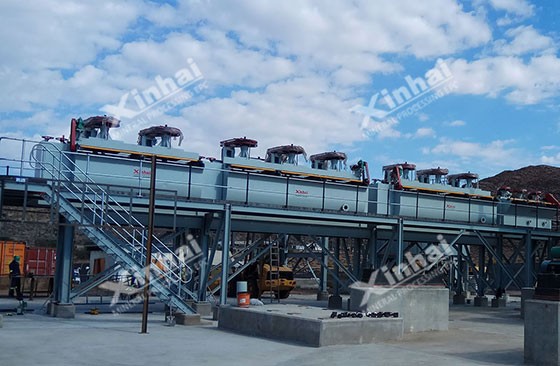

Warm Tip: If you want to know more details about equipment, solutions, etc, please click the button below for free consultation, or leave your requirements!
Flotation machine is the core equipment in the froth flotation process, and the froth flotation process is the most complex process in mineral processing technologies. There are many kinds of froth flotation processes, such as preferential flotation, bulk flotation, partial bulk- preferential flotation, iso-flotation, ash flotation, instant flotation, etc.
And the froth flotation process can be divided into one stage froth flotation process, two stage froth flotation (also known as stage flotation) process. The process refers to the generic terms of ore pulp through various flotation operations, and the number of stages is the number by the combination of grinding and froth flotation.
So how do you choose the froth flotation process according to the stage? Generally, the stage of froth flotation mainly depends on the dissemination characteristics of useful minerals.

One. One stage froth flotation
One stage froth flotation is the froth flotation process after a primary grinding (the ore is ground to the upper limit of particle size that can float), and any flotation products do not need to regrinding, that is called one stage froth flotation process, or one stage grinding-froth flotation process.
Application:
1. One stage froth flotation is suitable to the minerals whose disseminated grain size of useful mineral is uniform, and the mineral size is relatively coarse and not easy to muddy. For example, when the sulfide ore of heavy metal is 0.3mm, the useful mineral can achieve monomer separation basically. The qualified concentrate and abandoned tailings can be obtained by froth flotation after rough grinding.
2. One stage froth flotation is suitable to the minerals whose disseminated grain size of useful mineral is fine but not very uniform and not easy to be muddy. this process is also a flotation process, which can be used for continuous grinding of such minerals for two times before entering into flotation, and then there is no need to grind again. For example, in order to achieve monomer separation of useful minerals, the grain size of some crystalline minerals needs to be ground to below -0.074mm. The crystal size of this mineral is fine and uniform, which meets the requirements of a stage of flotation.

Two. Stage froth flotation
The stage froth flotation is mainly because the disseminated grain size of ore is unevenly, so the grinding operation needs to be carried out after the one stage froth flotation, which is called the two stage froth flotation process. By that analogy, there are multiple stage froth flotation process.
The main purpose of stage froth flotation is to avoid the overcrushing and argillization phenomenon of of useful minerals and gangue minerals in the ore, and make the gangue can be discharged astailings at a coarser particle size as far as possible. Sometimes, stage froth flotation is also used to separate partial monomer dissociated coarse-grain concentrate.
This process is mainly used to deal with the ore with complex grain size of useful mineral or the ore with muddy phenomenon in the grinding process. The stage froth flotation can be divided into three forms: concentrate regrinding, middlings regrinding and tailings regrinding.
1. Concentrate regrinding
Concentrate regrinding is that the ore contains two or more kind of useful mineral, they are linked to each other, and each of the useful minerals has the finer grain size, but their aggregate is coarser. concentrate regrinding can be used in this case.
One stage grinding adopts coarse grinding to dissociate the aggregate of useful minerals from gangue ore, and then carries out froth flotation to obtain mixed concentrate and tailings, and then secondary grinding is used to make the aggregate achieve monomer separation, and then froth flotation is carried out to obtain each kind of useful mineral concentrate.
2. Middlings regrinding
The disseminated grain size of useful minerals in the ore are not even and the distribution of useful minerals is not even in the ore, so middlings regrinding can be used.
One stage grinding dissociates the coarse grain and useful minerals, the produced gangue minerals directly enter the tailings,and a part of the mineral contains the coenobium of fine grain and useful minerals enters the froth flotation, so that the coarse concentrate and the discarded tailings can be obtained. In addition, some of the coenobium minerals need the regrinding to realize the monomer separation, then enter the froth flotation stage to select the useful fine-grained minerals.
3. Tailings regrinding
The disseminated grain size of useful minerals in the ore are not even, but the distribution of useful minerals is uniform in the ore, tailings regrinding can be used in this case.
One stage grinding makes the coarse grain achieve the monomer separation, part of concentrate can be obtained after the froth flotation, and the tailings contain the fine-grain useful mineral is sent to regrinding and re-flotation to select the useful fine minerals. This process can also be used for ore that is easily oxidized or easily argillized.
The above is the several common froth flotation processes, which play an important role in the mineral processing index, so selecting the reasonable froth flotation process is a main factor to ensure the best mineral processing index and the lowest production cost.
Therefore, when choosing the froth flotation process, it is necessary to find a reliable mining enterprise to conduct the mineral processing test, then decide the reasonable froth flotation process that conforms to the mine conditions.
Last: 4 Ways to Teach You How to Improve the Index of Extraction of Tin Ore
Next: 7 Daily Operation Skills and 5 Maintenance Points of Shaking Table
14 Q&A You Need to Know About Froth Flotation Process
 0
0
 2813
2813
2Ultimate Guide of Gold Flotation Process
 3
3
 4340
4340
3Hazards of Mineral Processing Wastewater in Flotation Plant
 0
0
 2718
2718
